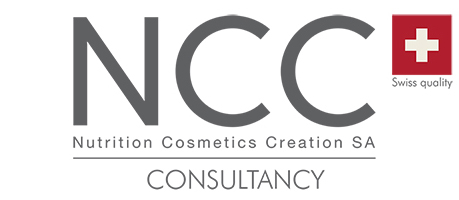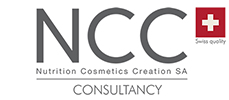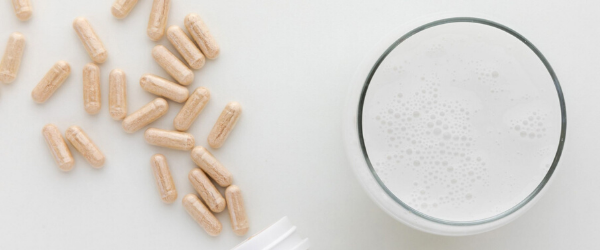Article produced in collaboration with INGREDIA, manufacturer of ingredients for the health industry.
Lactoferrin, the new flagship ingredient in cosmetics (Out) and nutrition (In)? Re-discover this milk protein and its numerous In & Out benefits on skin diseases and their healing, such as acne or psoriasis. But also on the oral health and physical condition of athletes. Multi-potential and innovative, will it be at the heart of your next development?
What is lactoferrin?
It is an iron-binding glycoprotein naturally present in milk.
It is mainly known for its immune health properties, and is used in particular to combat COVID-19. However, you may not be aware of its cosmetic properties, especially for skin and dental health.

Lactoferrin and acne
Various studies show an improvement in skin quality after consumption of chewable tablets or milk enriched with lactoferrin.
In this context, we can mention a study by researcher Kim. This study shows a reduction in acne grade of 20.3% compared to the placebo group at 12 weeks. (Kim et al., 2010)
Thus, lactoferrin in mild to moderate acne vulgaris is well tolerated and leads to an overall improvement in the number of acne lesions.
Lactoferrin and psoriasis
Lactoferrin could be included as a safe cutaneous therapeutic option in the treatment of psoriatic plaque.
Saraceno’s research team demonstrates that topical application with 10% lactoferrin in an ointment coupled with oral lacto ferrin supplementation can improve the stability of psoriatic plaque. (Saraceno et al., 2014)
Lactoferrin and skin healing
Lactoferrin supports multiple biological processes involved in wound healing.
Two in vitro studies can be cited in this respect:
The first, by Tang’s team, demonstrates that lactoferrin directly promotes granulation tissue formation and re-epithelialisation (wound healing) (. (Tang et al, 2010)
The second, from the team of Takayama and Aoki, demonstrates that lactoferrin improves the synthesis of extracellular matrix components, such as collagen and hyaluronan. (Takayama and Aoki, 2012)

Lactoferrin and oral health: periodontal disease, bad breath and plaque control
Lactoferrin supplementation can be effective in the treatment of periodontal disease. (Ishikado et al., 2010).
This study shows that the condition of the gums is significantly improved by lactoferrin supplementation (180 mg tablet) after 4 weeks compared to the beginning of the treatment.
In addition, a second study also shows that lactoferrin and lactoperoxidase improve bad breath with a probable action on oral bacteria. (Shin et al, 2011).
Finally, an in vitro study conducted with Proferrin®, Ingredia’s lactoferrin, shows the effect on plaque reduction. This study shows that a native lactoferrin, i.e. with a structure identical to that found in milk, is more effective than a denatured lactoferrin
If its use in OUT has been demonstrated, what can it bring to your IN formulations, through dietary intake? Here are a few examples of interest for athletes.
Strengthening the athlete’s immunity
Athletes use energy mainly for the benefit of the muscles, both during exercise and recovery. This is at the expense of immune cell synthesis. As a result, in the long term, an athlete’s immune system tends to weaken. This is why athletes often need to boost their immune health through supplementation.

Increase performance in athletes
Relieve inflammation
According to FIFA, 30% of professional football players use anti-inflammatory drugs. Who hasn’t felt pain or exhaustion after physical activity? Competition or regular training can affect muscles or joints and cause damage or injury. Therefore, the body’s natural response to this is inflammation. Its signs are redness, swelling, pain or fatigue. Inflammation is part of the body’s immune response.
Lactoferrin is now recognised as one of the very few bioactives that reduce inflammation. This is why many scientific studies support the anti-inflammatory action of lactoferrin.
Preventing iron deficiency
Athletes are often concerned about iron, as it is part of the haemoglobin in the blood and myoglobin in the muscles, contributing to the oxygen supply to the cells. Iron ensures that the muscles function properly. In addition, it helps the body convert carbohydrates into energy during exercise.
Endurance athletes such as long-distance runners, especially women and adolescents, are at high risk of anaemia. Intense training increases iron requirements, and exercise can deplete iron stores through sweating. Therefore, iron supplements are necessary.
In addition, lactoferrin is a well-known natural iron-binding protein found in milk or colostrum.
A clinical study was carried out on women runners who were supplemented for a period of 8 weeks with 450 mg of Lactoferrin together with 5 mg of iron. This study showed that the haematocrit parameters of the Lactoferrin group remained stable compared to the placebo group and 5 mg of iron, whose blood factors worsened.
This shows that Lactoferrin is a natural way to prevent iron deficiency in male and female athletes.
To read too:
- White label, a solution?
- Probiotics: What is this new trend consisting of bacteria for In & Out use?
- Cosmetic Packaging: Airless, bio-sourced & refillable for greener products
- Cosmetics: towards green formulation
- Powdered cosmetics, a trend to follow?
- Regulation and development of cosmetic ranges or well-being products
Do you want to develop new products? Discover our free In&Out product catalogue!



